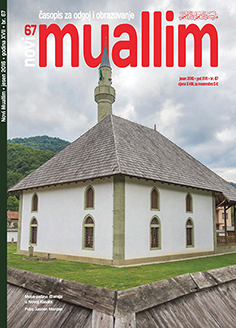HOW THE COMMUNISTS USED PRIMARY SCHOOL TEACHERS FOR THE IMPLEMENTATION OF THEIR POLICIES (1945 – 1951)
DOI:
https://doi.org/10.26340/muallim.v17i67.366Keywords:
primary school, Ministry of Education of the People’s Republic of Bosnia and Herzegovina, primary school teachers, teacher deployment, pedagogical seminarsAbstract
UDK 371.213(497.6)"1945/1951"(091)
In the period after the Second World War, a tumultuous time in the history of Bosnia and Herzegovina that saw big social changes, educators and, especially, primary school teachers played not just a cultural-educational, but also an immensely important socio-political role in the education and creation of loyal socialist subjects for the ruling Yugoslav Communist Party. Primary school teachers were a firm support for the socialist authorities, because they brought a new spirit into the teaching and upbringing of the youth and influenced the inhabitants of local communities to be socially active. Based on original archival sources, which so far have hardly been used, this contribution deals with the following topics: what was the socio-political significance of primary schools and primary school teachers for the creation of the new socialist citizen; what was the social and economic status of the primary school teaching cadre in the gap between big political demands, hard working conditions and modest rewards and how did the representatives of the new state educational apparatus “train” primary school teachers in order to carry out the new educational policies. Two modes are described, one, which was publicly proclaimed and published in official documents of the Ministry of Education of the People’s Republic of Bosnia and Herzegovina and a second, hidden mode which was not publicized, but its goals can be “inferred” by accessible archival documents.
Downloads
Published
How to Cite
Issue
Section
License
Naknada:
a. Časopis ne naplaćuje naknadu za obradu članaka (APC) i naknadu za podnošenje članaka.
Autori koji objavljuju u ovom časopisu pristaju na sljedeće uvijete:
- Autori zadržavaju autorska prava i pružaju časopisu pravo prvog objavljivanja, pri čemu će rad jednu godinu po objavljivanju biti podložan licenci Creative Commons imenovanje koja omogućuje drugima da dijele rad uz uvijet navođenja autorstva i izvornog objavljivanja u ovom časopisu.
- Autori mogu izraditi zasebne, ugovorne aranžmane za ne-ekskluzivnu distribuciju rada objavljenog u časopisu (npr. postavljanje u institucionalni repozitorij ili objavljivanje u knjizi), uz navođenje da je rad izvorno objavljen u ovom časopisu.


